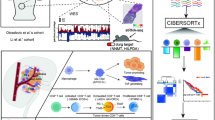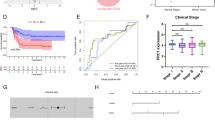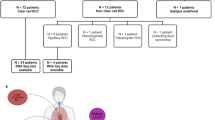Abstract
Nephroblastoma, colloquially known as Wilms’ tumour (WT), is the predominant malignant renal neoplasm arising in the paediatric population. Modern therapeutic approaches for WT incorporate a synergistic combination of surgical intervention, radiotherapy, and chemotherapy, which substantially ameliorate the overall patient survival rate. Despite this, the optimal sequence of chemotherapy and surgical intervention remains a matter of contention, with each strategy presenting its own strengths and weaknesses that could influence clinical decision-making. To make some headway on this clinical dilemma, we deployed a multidimensional transcriptomics integration approach by analysing bulk RNA sequencing data with 136 samples, as well as single-nucleus RNA sequencing (snRNA-seq) and paired spatial transcriptome sequencing (stRNA) data from 32 WT specimens. Our findings identified a distinct elevation of RNF34 expression within WT samples, which correlated with unfavourable prognostic outcomes. Leveraging the Genomics of Drug Sensitivity in Cancer (GDSC), we simultaneously revealed that patients with high expression of RNF34 have higher sensitivity to commonly used chemotherapy drugs for WT. Furthermore, our analysis of snRNA and stRNA data unveiled a reduced proportion of RNF34 expression in neoplastic cells after chemotherapy. Moreover, stRNA data delineated a significant association between a higher proportion of RNF34 expression in cancer cells and adverse features such as anaplastic histology and tumour recurrence. Intriguingly, we also observed a close association between elevated RNF34 expression and a characteristic exhausted tumour immune microenvironment. Collectively, our findings underscore the pivotal role of RNF34 in the prognostic prediction potential and treatment sensitivity of WT. This comprehensive analysis can potentially inform and refine clinical decision-making for WT patients and guide future studies towards the development of optimized, rational therapeutic strategies.






Similar content being viewed by others
Data Availability
The bulk RNA-seq data and clinical data of Wilms’ tumour (WT) tissue samples were sourced from the Therapeutically Applicable Research to Generate Effective Treatments (TARGET) database. The GSE2712 cohort and GSE66405 cohort were accessed from the Gene Expression Omnibus (GEO) database using the GEOquery R package. In addition, the pairs of snRNA-seq data and stRNA data were obtained from the Single-cell Pediatric Cancer Atlas Portal (https://scpca.alexslemonade.org/).
References
Das, A., Tanigawa, S., Karner, C. M., Xin, M., Lum, L., Chen, C., et al. (2013). Stromal-epithelial crosstalk regulates kidney progenitor cell differentiation. Nature Cell Biology, 15(9), 1035–1044.
Fetting, J. L., Guay, J. A., Karolak, M. J., Iozzo, R. V., Adams, D. C., Maridas, D. E., et al. (2014). FOXD1 promotes nephron progenitor differentiation by repressing decorin in the embryonic kidney. Development, 141(1), 17–27.
Perotti, D., Hohenstein, P., Bongarzone, I., Maschietto, M., Weeks, M., Radice, P., et al. (2013). Is Wilms tumor a candidate neoplasia for treatment with WNT/beta-catenin pathway modulators? A report from the renal tumors biology-driven drug development workshop. Molecular Cancer Therapeutics, 12(12), 2619–2627.
Nakata, K., Colombet, M., Stiller, C. A., Pritchard-Jones, K., Steliarova-Foucher, E., Contributors I. (2020). Incidence of childhood renal tumours: An international population-based study. International Journal of Cancer, 147(12), 3313–27.
D’Angio, G. J., Evans, A., Breslow, N., Beckwith, B., Bishop, H., Farewell, V., et al. (1981). The treatment of Wilms’ tumor: Results of the Second National Wilms’ Tumor Study. Cancer, 47(9), 2302–2311.
Nelson, M. V., van den Heuvel-Eibrink, M. M., Graf, N., & Dome, J. S. (2021). New approaches to risk stratification for Wilms tumor. Current Opinion in Pediatrics, 33(1), 40–48.
de la Monneraye, Y., Michon, J., Pacquement, H., Aerts, I., Orbach, D., Doz, F., et al. (2019). Indications and results of diagnostic biopsy in pediatric renal tumors: A retrospective analysis of 317 patients with critical review of SIOP guidelines. Pediatric Blood & Cancer, 66(6), e27641.
Zhang, R., Zhao, J., Song, Y., Wang, X., Wang, L., Xu, J., et al. (2014). The E3 ligase RNF34 is a novel negative regulator of the NOD1 pathway. Cellular Physiology and Biochemistry, 33(6), 1954–1962.
Konishi, T., Sasaki, S., Watanabe, T., Kitayama, J., & Nagawa, H. (2005). Overexpression of hRFI (human ring finger homologous to inhibitor of apoptosis protein type) inhibits death receptor-mediated apoptosis in colorectal cancer cells. Molecular Cancer Therapeutics, 4(5), 743–750.
McDonald, E. R., 3rd., & El-Deiry, W. S. (2004). Suppression of caspase-8- and -10-associated RING proteins results in sensitization to death ligands and inhibition of tumor cell growth. Proceedings of the National Academy of Sciences of the United States of America, 101(16), 6170–6175.
Thompson, C. B. (1995). Apoptosis in the pathogenesis and treatment of disease. Science, 267(5203), 1456–1462.
Konishi, T., Sasaki, S., Watanabe, T., Kitayama, J., & Nagawa, H. (2006). Overexpression of hRFI inhibits 5-fluorouracil-induced apoptosis in colorectal cancer cells via activation of NF-kappaB and upregulation of BCL-2 and BCL-XL. Oncogene, 25(22), 3160–3169.
Sasaki, S., Kitayama, J., Watanabe, T., Konishi, T., & Nagawa, H. (2004). Diffuse expression of hRFI is correlated with blood vessel invasion in gastric carcinoma. Japanese Journal of Clinical Oncology, 34(10), 584–587.
Sasaki, S., Watanabe, T., Konishi, T., Kitayama, J., & Nagawa, H. (2004). Effects of expression of hRFI on adenoma formation and tumor progression in colorectal adenoma-carcinoma sequence. Journal of Experimental & Clinical Cancer Research, 23(3), 507–512.
Cutcliffe, C., Kersey, D., Huang, C. C., Zeng, Y., Walterhouse, D., Perlman, E. J., et al. (2005). Clear cell sarcoma of the kidney: Up-regulation of neural markers with activation of the sonic hedgehog and Akt pathways. Clinical Cancer Research, 11(22), 7986–7994.
Ludwig, N., Werner, T. V., Backes, C., Trampert, P., Gessler, M., Keller, A., et al. (2016). Combining miRNA and mRNA expression profiles in wilms tumor subtypes. International Journal of Molecular Sciences, 17(4), 475.
Davis, S., & Meltzer, P. S. (2007). GEOquery: A bridge between the Gene Expression Omnibus (GEO) and BioConductor. Bioinformatics, 23(14), 1846–1847.
Yoshihara, K., Shahmoradgoli, M., Martinez, E., Vegesna, R., Kim, H., Torres-Garcia, W., et al. (2013). Inferring tumour purity and stromal and immune cell admixture from expression data. Nature Communications, 4, 2612.
Hänzelmann, S., Castelo, R., & Guinney, J. (2013). GSVA: Gene set variation analysis for microarray and RNA-seq data. BMC Bioinformatics, 14, 7.
Barbie, D. A., Tamayo, P., Boehm, J. S., Kim, S. Y., Moody, S. E., Dunn, I. F., et al. (2009). Systematic RNA interference reveals that oncogenic KRAS-driven cancers require TBK1. Nature, 462(7269), 108–112.
Charoentong, P., Finotello, F., Angelova, M., Mayer, C., Efremova, M., Rieder, D., et al. (2017). Pan-cancer immunogenomic analyses reveal genotype-immunophenotype relationships and predictors of response to checkpoint blockade. Cell Reports, 18(1), 248–262.
Yu, G., Wang, L. G., Han, Y., & He, Q. Y. (2012). clusterProfiler: An R package for comparing biological themes among gene clusters. OMICS: A Journal of Integrative Biology, 16(5), 284–287.
Yang, W., Soares, J., Greninger, P., Edelman, E. J., Lightfoot, H., Forbes, S., et al. (2013). Genomics of Drug Sensitivity in Cancer (GDSC): A resource for therapeutic biomarker discovery in cancer cells. Nucleic Acids Research, 41, D955-61.
Geeleher, P., Cox, N. J., & Huang, R. S. (2014). Clinical drug response can be predicted using baseline gene expression levels and in vitro drug sensitivity in cell lines. Genome Biology, 15(3), R47.
Yuan, R., Chen, S., & Wang, Y. (2020). Computational prediction of drug responses in cancer cell lines from cancer omics and detection of drug effectiveness related methylation sites. Frontiers in Genetics, 11, 917.
Yang, C., Chen, J., Li, Y., Huang, X., Liu, Z., Wang, J., et al. (2021). Exploring subclass-specific therapeutic agents for hepatocellular carcinoma by informatics-guided drug screen. Briefings in Bioinformatics, 22(4), bbaa295.
Dome, J. S., Graf, N., Geller, J. I., Fernandez, C. V., Mullen, E. A., Spreafico, F., et al. (2015). Advances in Wilms Tumor Treatment and Biology: Progress through international collaboration. Journal of Clinical Oncology, 33(27), 2999–3007.
Young, M. D., Mitchell, T. J., Vieira Braga, F. A., Tran, M. G. B., Stewart, B. J., Ferdinand, J. R., et al. (2018). Single-cell transcriptomes from human kidneys reveal the cellular identity of renal tumors. Science, 361(6402), 594–599.
Wu, H., Kirita, Y., Donnelly, E. L., & Humphreys, B. D. (2019). Advantages of single-nucleus over single-cell RNA sequencing of adult kidney: Rare cell types and novel cell states revealed in fibrosis. Journal of the American Society of Nephrology, 30(1), 23–32.
Slyper, M., Porter, C. B. M., Ashenberg, O., Waldman, J., Drokhlyansky, E., Wakiro, I., et al. (2020). A single-cell and single-nucleus RNA-Seq toolbox for fresh and frozen human tumors. Nature Medicine, 26(5), 792–802.
Guo, Y., Wang, W., Ye, K., He, L., Ge, Q., Huang, Y., et al. (2023). Single-nucleus RNA-seq: Open the era of great navigation for FFPE tissue. International Journal of Molecular Sciences, 24(18), 13744.
Sasaki, S., Nakamura, T., Arakawa, H., Mori, M., Watanabe, T., Nagawa, H., et al. (2002). Isolation and characterization of a novel gene, hRFI, preferentially expressed in esophageal cancer. Oncogene, 21(32), 5024–5030.
Binnewies, M., Roberts, E. W., Kersten, K., Chan, V., Fearon, D. F., Merad, M., et al. (2018). Understanding the tumor immune microenvironment (TIME) for effective therapy. Nature Medicine, 24(5), 541–550.
Acknowledgements
This work was supported by the Guangxi Natural Science Foundation (No. 2022GXNSFAA035641 and No. 2023GXNSFAA026134), the Scientific Research Project of Guangxi Provincial Health and Family Planning Commission (No. Z20200317) “Medical Excellence Award” Funded by the Creative Research Development Grant from the First Affiliated Hospital of Guangxi Medical University.
Author information
Authors and Affiliations
Contributions
JZ, FL, CS, CW and XC contributed to the study design; FL, JT and SC performed immunohistochemistry; JT, SC, JS, XO, MD and HC collected samples and patient information; JZ, FL contributed to the bioinformatics analyses; CS, CW and XC directed the study, obtained funding, and revised the manuscript. JZ and FL wrote the manuscript. All authors read and approved the final manuscript.
Corresponding authors
Ethics declarations
Conflict of interest
There were no conflicts of interest of any authors in relation to the submission.
Additional information
Publisher's Note
Springer Nature remains neutral with regard to jurisdictional claims in published maps and institutional affiliations.
Supplementary Information
Below is the link to the electronic supplementary material.
12033_2023_1008_MOESM1_ESM.tif
Supplementary file1 Supplementary Figure 1. Expression comparison of RNF34 between relapse situation based on snRNA data. (A) Featureplot displaying the expression of RNF34 with no relapse (left) and relapse (right). (B) Expression ratio of RNF34 in different cell-types between relapse-no and relapse-yes patients. Cells were defined as RNF34-high group if they expressed RNF34 and as RNF34-low group if they did not express RNF34. (TIF 4747 KB)
12033_2023_1008_MOESM2_ESM.tif
Supplementary file2 Supplementary Figure 2. Expression comparison of RNF34 between anaplastic and favourable patients based on snRNA data. (A) Featureplot displaying the expression of RNF34 between anaplastic (left) and favourable patients (right). (B) Expression ratio of RNF34 in different cell-types between anaplastic and favourable patients. Cells were defined as RNF34-high group if they expressed RNF34 and as RNF34-low group if they did not express RNF34. (TIF 4787 KB)
12033_2023_1008_MOESM3_ESM.tif
Supplementary file3 Supplementary Figure 3. Expression characteristics of RNF34 based on stRNA data. (A) Featureplot showing the expression of RNF34 in spatial locations. The pie plot reveals the number of RNF34-positive cells in cancer cells. Tumour cells were defined as RNF34-high group if they expressed RNF34 and as RNF34-low group if they did not express RNF34 (TIF 281719 KB)
Rights and permissions
Springer Nature or its licensor (e.g. a society or other partner) holds exclusive rights to this article under a publishing agreement with the author(s) or other rightsholder(s); author self-archiving of the accepted manuscript version of this article is solely governed by the terms of such publishing agreement and applicable law.
About this article
Cite this article
Zheng, J., Liu, F., Tuo, J. et al. Multidimensional Transcriptomics Unveils RNF34 as a Prognostic Biomarker and Potential Indicator of Chemotherapy Sensitivity in Wilms’ Tumour. Mol Biotechnol 66, 1132–1143 (2024). https://doi.org/10.1007/s12033-023-01008-2
Received:
Accepted:
Published:
Issue Date:
DOI: https://doi.org/10.1007/s12033-023-01008-2




